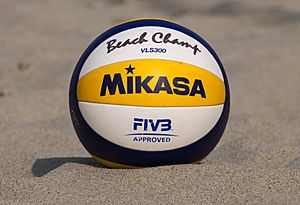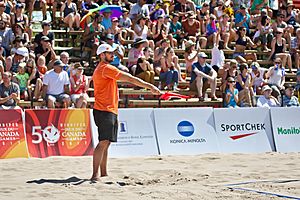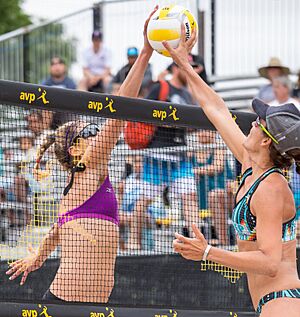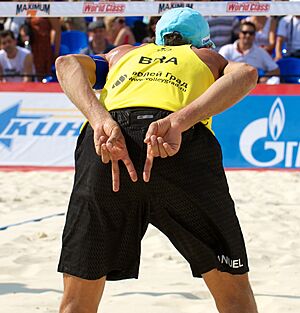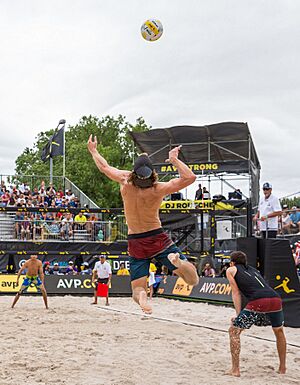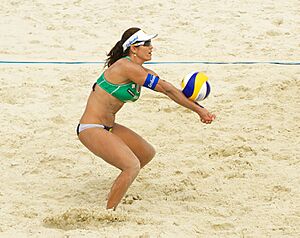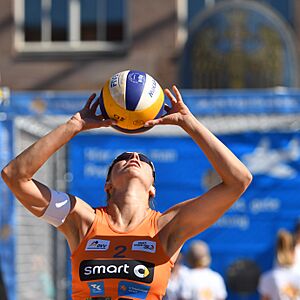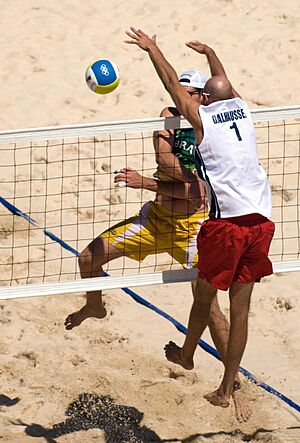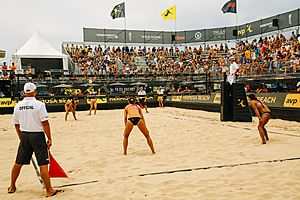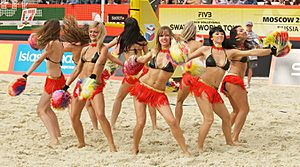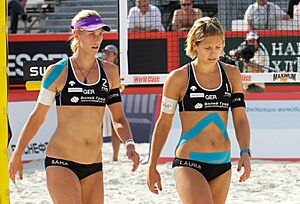Beach volleyball facts for kids
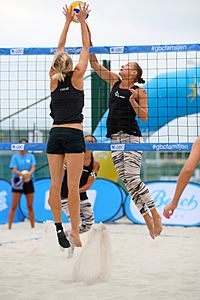
The blocker (left) attempts to stop the opposing team's attack over the net.
|
|
| Highest governing body | FIVB |
|---|---|
| First played | 1915, Waikiki, Hawaii, United States |
| Characteristics | |
| Contact | No |
| Team members | 2 or more per side |
| Mixed-sex | Single and mixed |
| Type | Outdoor, team sport, net sport |
| Equipment | Beach volleyball |
| Glossary | Volleyball jargon |
| Presence | |
| Country or region | Worldwide |
| Olympic | Since 1996 |
| World Games | 1993 |
Beach volleyball is an exciting team sport. It is played on a sand court with a net in the middle. Two teams, usually with two players each, try to hit a ball over the net. The goal is to make the ball land on the other team's side. Teams also work together to stop the opponent from scoring.
Each team can touch the ball up to three times to send it back over the net. A player cannot touch the ball twice in a row. The only exception is after a block attempt. The game starts with a "serve." A player hits the ball from behind the court line. The ball must go over the net to the other side. The receiving team usually uses their three touches to pass, set, and then attack the ball. On defense, one player often blocks at the net. Another player covers the rest of the court. The game continues until the ball hits the sand. It also stops if the ball goes "out" or a mistake is made. The team that wins the point serves next. Players serve in a set order throughout the game.
Beach volleyball likely started in 1915 in Waikiki, Hawaii. The modern game with two players began in Santa Monica, California. It became an Olympic sport in 1996. The Fédération Internationale de Volleyball (FIVB) is the main group that runs the sport worldwide. They organize big events like the FIVB Beach Volleyball World Championships.
History of Beach Volleyball

Beach volleyball is a version of indoor volleyball. Indoor volleyball was invented in 1895. Beach volleyball probably started in 1915. This was at the Outrigger Canoe Club on Waikiki Beach in Hawaii. A club member, George David "Dad" Center, put up a net. The first recorded game of beach volleyball happened there.
In 1920, new jetties in Santa Monica, California created big sandy areas. People could enjoy these public beaches. This helped beach volleyball grow in that area. Soon, permanent nets appeared. People started playing games on public beaches and in private clubs. Eleven beach clubs opened in Santa Monica by late 1922. The first games between clubs happened in 1924.

Most early beach volleyball games had at least six players per side. This was like indoor volleyball. The idea for the modern two-player game came from Paul "Pablo" Johnson. He was from the Santa Monica Athletic Club. In 1930, he was waiting for players for a six-person game. Only four people were there. So, Johnson decided to play with two teams of two. This was the first recorded doubles game. Players realized that with fewer people, a tall player's height advantage could be balanced. A shorter player's speed and ball control could make a difference. The two-player game became popular. It spread to other beach clubs and public courts. Today, the two-player game is the most common. It is also the only one played at the top professional level.
Beach volleyball became more popular in the United States in the 1930s. It was a cheap activity during the Great Depression. The sport also started in Europe around this time. By the 1940s, doubles tournaments were played in Santa Monica for trophies. In 1948, the first tournament with a prize was held in Los Angeles. The winning teams received a case of Pepsi. In the 1960s, a try to start a professional league failed. But a professional tournament in France offered 30,000 French francs. The first Brazilian beach volleyball tournament was held in the 1950s. The first Manhattan Beach Open was in 1960. This tournament became very famous. Some call it the "Wimbledon of Beach Volleyball."
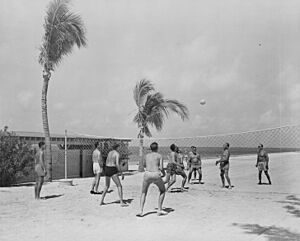
Beach volleyball kept growing in popularity. In the 1960s, The Beatles tried playing in Los Angeles. US president John F. Kennedy was seen at a match. In 1974, an indoor tournament was held. It was called "The $1500.00 World Indoor Two-Man Volleyball Championship." Four thousand fans watched in San Diego. Fred Zuelich and Dennis Hare won. Dennis Hare later wrote the first book on beach volleyball. It was called The Art of Beach Volleyball.
The first professional beach volleyball tournament was in 1976. It was the Olympia World Championship of Beach Volleyball. It took place at Will Rogers State Beach in California. David Wilk of Volleyball magazine organized it. The first "world champions" were Greg Lee and Jim Menges. They shared US$2,500 from a total prize of US$5,000.
Volleyball magazine held the event again the next year. In 1978, Wilk started a company called Event Concepts. They moved the World Championship to Redondo Beach, California. Jose Cuervo became a sponsor. The event was a success. Cuervo helped fund an expansion the next year. The California Pro Beach Tour started with three events. By 1984, the Pro Beach Tour had 16 events. It offered US$300,000 in prizes. Later that year, Event Concepts faced problems. Players went on strike at the World Championship. This led to the creation of the Association of Volleyball Professionals (AVP). In 1987, the Women's Professional Volleyball Association started. It lasted until 1997. Then, the women joined the AVP tour.
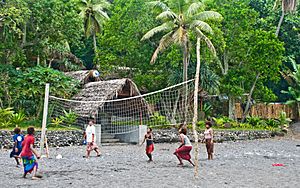
At the professional level, the sport became more known in the 1980s. Famous players like Sinjin Smith, Randy Stoklos, and Karch Kiraly helped. Kiraly won an Olympic gold medal in beach volleyball in 1996. He had already won two Olympic golds in indoor volleyball. In the 1980s, the sport grew popular on the beaches of Copacabana and Ipanema in Rio de Janeiro, Brazil. In 1986, the first international beach volleyball show was held in Rio. Five thousand people watched.
In 1987, the first international tournament approved by the FIVB was played. It was on Ipanema beach in Rio. It had US$22,000 in prizes. Sinjin Smith and Randy Stoklos won. In 1989, the FIVB started its first international series. It was called the World Series. It had men's tournaments in Brazil, Italy, and Japan. The FIVB helped prepare the sport for its Olympic debut in 1996. The first FIVB Beach Volleyball World Championships were held the next year. By 1998, the sport was part of other big events. These included the Pan American Games and Goodwill Games.
Rules of Beach Volleyball
The Fédération Internationale de Volleyball (FIVB) is the main group for beach volleyball. The FIVB publishes the official rules every four years. These rules explain how beach volleyball is played around the world. The rules have changed over time. The court size got smaller. Scoring changed so every serve could earn a point. Also, "let serves" (where the ball touches the net but goes over) are now allowed. Beach volleyball is different from indoor volleyball. One key difference is needing "clean hands" when setting the ball.
The Court
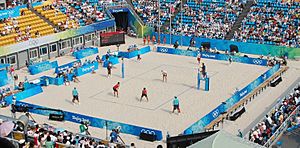
Beach volleyball is played on a sand court. The court is 16 meters (about 52.5 feet) long. It is 8 meters (about 26 feet) wide. There must be at least 3 meters (about 10 feet) of clear space around it. The sand should be flat and safe. There should be no rocks that could hurt players.
A net divides the court in half. The net is 8.5 meters (about 28 feet) long and 1 meter (about 3.3 feet) wide. For men, the top of the net is 2.43 meters (about 8 feet) high. For women, it is 2.24 meters (about 7.3 feet) high. These heights change for younger or older players. An antenna is attached to each side of the net. They are 1.8 meters (about 6 feet) long. These antennae are part of the net. They stick up 80 cm (about 31.5 inches) above it. They show the side boundaries for the ball to cross.
Two side lines and two end lines mark the playing court. They are 5 cm (about 2 inches) wide.
The Ball
FIVB rules say the ball must be round. It must be made of waterproof, flexible material. This makes it good for outdoor play. A beach volleyball is 66–68 cm (about 26-27 inches) around. It weighs 260–280 grams (about 9-10 ounces). It has a lower air pressure than indoor balls. The official ball for the AVP tour is the Wilson OPTX AVP. The official ball for the FIVB tour is the Mikasa VLS300.
Teams
A team has two players. Both players must always be on the court. No substitutions are allowed. When the server hits the ball, both players must be in their own court. But there are no fixed positions on the court. This means players can move anywhere. No "positional faults" can be made.
Scoring Points
Point, Set, Match
A team scores a point when:
- The ball lands on the other team's court.
- The other team hits the ball "out."
- The other team makes a mistake (a "fault").
- The other team gets a penalty.
The team that wins the point serves next. The ball is "out" if it:
- Lands completely outside the court lines. (If any part touches a line, it's "in.")
- Touches something or someone outside the court.
- Touches the net's antennae.
- Does not cross the net between the antennae. This applies during a serve or the third touch.
- Goes completely under the net.
A "set" is won by the first team to reach 21 points. They must have at least a two-point lead. If the score is 20-all, play continues until one team leads by two points. In the final set, it's 15 points with a two-point lead. A "match" is won by the team that wins two sets.
Faults
A fault happens when a team breaks a rule. If a team makes a fault, the other team gets a point. They also get to serve. If both teams make a fault at the same time, the point is replayed.
Common faults include:
- Four hits: A team touches the ball more than three times before sending it over the net.
- Assisted hit: A player uses a teammate or object to help hit the ball.
- Double contact: A player touches the ball twice in a row. This is allowed only after a block touch.
- Catch/lift: A player catches or throws the ball instead of hitting it.
- Service order fault: A team serves when it's not their turn.
- Foot fault: A player's foot touches the court line before or during a serve.
- Net touch: A player touches the net between the antennae while playing the ball.
Major Rule Changes
In the 1990s, the Fédération Internationale de Volleyball changed the ball. They made the beach volleyball ball softer. Its size also increased slightly.
In 2001, the FIVB tested new rules. The court size became smaller. It went from 9x18 meters to 8x16 meters. The scoring system also changed. Before, only the serving team could score points. Now, a point is scored on every serve. This is called "rally scoring." The Association of Volleyball Professionals (AVP) adopted these changes. Many players did not like them at first. The new rules became official in 2002.
Differences with Indoor Volleyball
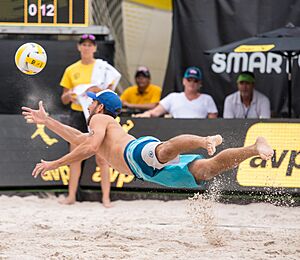
Beach volleyball is similar to indoor volleyball. But there are some key differences. These differences change how players plan, play, and use their skills.
Here are the main differences in rules:
- Facilities and Equipment
- Playing surface: Beach volleyball is played on sand. Indoor volleyball is on hard courts. Sand makes it harder to move and jump. But it also means fewer injuries like knee pain. Players usually play barefoot or with special "sand socks."
- Environment: Beach games are often outdoors. Wind, rain, and sun affect how players play.
- Court size: A beach volleyball court is 8x16 meters. This is a bit smaller than the 9x18 meter indoor court.
- Balls: Beach volleyballs are waterproof. They are slightly larger than indoor balls. They have a rougher feel and lower air pressure. This helps them work better outdoors.
- Players
- Number of players: A beach volleyball team has two players. No substitutions are allowed. Indoor volleyball has six players and allows substitutions. This means beach players need to be good at everything. They can't just specialize in one skill. Fewer players also mean more types of attack shots are used.
- Coaching: Coaches cannot give advice during matches. Some junior tournaments allow it during side switches.
- Player rules: Besides serving in order, there are no special rules for players.
- Players can attack from any spot.
- There are no "positional faults." Players can switch places whenever they want.
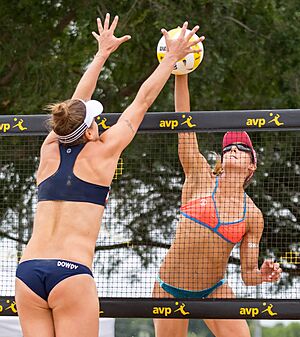
- Playing Format
- Scoring: Matches are best of 3 sets. Sets are played to 21 points. The deciding third set is played to 15 points.
- Switching sides: Teams switch ends of the court every seven points. In a deciding set, they switch every five points. This makes sure no team has an unfair advantage from wind or sun.
- Playing Actions
- Open hand tips and dinks: These are not allowed in two-player beach volleyball. They would make it too easy to score.
- Block touch: If a player blocks the ball, it counts as one of the three allowed touches. Either player can then touch the ball next.
- Crossing under the net: It is allowed to cross under the net. But you cannot interfere with the other team's play.
- Setting over the net: If you set the ball over the net as an attack, it must go straight over your shoulders.
- Time outs: Each team gets one time out per set. There is also an official time out in the first two sets. This happens when both teams' scores add up to 21 points.
How the Game is Played
Teams start on opposite sides of the net. One team serves first. The other team receives. A coin toss decides who serves first. It also decides which side teams start on for the first two sets. If a third set is needed, another coin toss happens. The serving order stays the same throughout the set.
To start a point, a player from the serving team "serves" the ball. They toss it up and hit it over the net. The goal is for it to land in the other team's court. The other team must use no more than three touches to send the ball back. A player cannot touch the ball twice in a row. This is allowed only after a block touch.
The three touches usually go like this:
- First, the receiving player "bumps" or "passes" the ball.
- Second, their teammate "sets" the ball. This aims it for the first player to hit.
- Third, the first player "spikes" or "shoots" the ball over the net. A spike is a strong hit. A shot is a softer, placed hit.
The team with the ball trying to attack is on offense.
The team on defense tries to stop the attack. A player at the net jumps to "block" the ball. They try to stop it from coming over. If the ball goes around or over the block, the defender tries to "dig" it. A dig is usually a forearm pass. After a good dig, the team goes from defense to offense.
The game continues like this, back and forth. It stops when the ball hits the court or a fault is made.
Teams switch sides of the court after every seven points in sets 1 and 2. In set 3, they switch every five points. This helps balance things like wind or sun. There is a technical time-out when the total score reaches 21 points. Each team can also ask for one extra time-out per set.
Player Roles
While there are no fixed positions, players often have special roles. These are for defense and offense.
On defense, players might be a blocker or a defender:
- Blocker: This player stays at the net. Their job is to block part of the court. They might block the "line" (straight down the sideline) or the "angle" (diagonal hit). Being tall, jumping well, and good timing are important for blocking.
- Defender: This player stands behind the blocker. Their job is to cover the part of the court the blocker doesn't. They try to "dig" hard spikes or chase down soft shots. Being quick and good at digging are important for defense.
Some teams don't have fixed roles. Both players take turns blocking and defending. This is called split blocking. It helps save energy, which is important on sand.
On offense, players often specialize in playing on the right side or left side of the court. This helps them receive serves better. It also helps them choose their shots. Left-handed players usually play on the right side. Right-handed players usually play on the left side. This makes it easier to spike the ball.
How to Hit the Ball
The ball can touch any part of the body. But it must be hit, not caught or thrown. The only exception is the serve. For a serve, only the hand or arm can touch the ball. A player can only touch the ball once per hit. If two players from the same team touch the ball at the same time, it counts as two hits. Either player can then make the next touch.
When two players from different teams touch the ball at the same time over the net, it's a joust. The team whose side the ball falls on gets three more touches.
When receiving a ball overhand with fingers, it must be touched "cleanly." If you receive the ball open-handed, both hands must touch the ball at the exact same time. This means serves are almost never received open-handed. When receiving a hard-hit attack, a slight double contact or lift is allowed. This is if both contacts happen in one action.
Attacks using an "open-handed tip or dink" are not allowed. This means directing the ball with just your fingers. Also, attacking with an overhand pass that doesn't go straight over your shoulders is illegal. These rules are different from indoor volleyball. They greatly affect how beach volleyball is played.
Block Signals
Beach volleyball players use hand signals. They show their partner what kind of block they plan to make. Or, if they are the defender, what block they want their partner to make. These signals are very important. They help the blocker and defender know which part of the court to cover. Signals are made behind the back so the other team can't see them. The serving player's partner usually gives them with both hands before the serve. The left hand signals for the opponent on the left side. The right hand signals for the opponent on the right side. A player might also "wiggle" a signal. This tells their partner which opponent to serve to.
Signals can also be given during a point. This happens while the other team is getting ready to attack.
Common Block Signals
- Closed fist: No block should be tried for that opponent. The blocker should move back from the net. They will play defense with the defender.
- One finger: The blocker should block an opponent's "line" hit. This is a hard hit straight down the sideline. The defender's job is to dig all "angle" attacks. They also chase any "line" shot that goes high over the block.
- Two fingers: The blocker should block an opponent's "angle" hit. This is a hard hit diagonally across the court. The defender's job is to dig all "line" attacks. They also chase any "angle" shot that goes high over the block.
- Open hand: The blocker should "read the ball." This means they decide how to block based on the opponent's set and hit. The defender also has freedom to defend as they see fit.
- Shaka: The blocker should spread their arms wide over the net. This is a "spread block." It blocks all hard hits that go low over the net. The defender's job is to dig any shot that goes over or around the block.
Skills in Beach Volleyball
There are several basic skills players need to learn. These include serving, passing, setting, attacking, blocking, and digging.
Serve
Serving is how you start the game. You hit the ball with your hand or arm from behind the back line. You can use an underhand or overhand serve. Examples include: float serve, jump-float serve, top-spin serve, and sky ball serve. Beach volleyball is outdoors. So, players think about wind and sun when serving. Wind can change how a serve flies. Players use different serves to use the wind to their advantage. For example, a top-spin serve into the wind can make the ball drop fast. A sky ball serve is good at noon. The sun can get in the receiver's eyes.
The server also chooses which opponent to serve to. The player who receives the serve will likely be the attacker. So, serving strategies can target a player's weaker skills. Even though serving can be strong, the receiving team often wins the point. They get the first chance to attack.
Pass
The pass is the first touch a team makes. In indoor volleyball, you can pass with your forearms (a "bump") or with your fingertips overhand. But in beach volleyball, you cannot double contact the first ball with an overhand finger action. So, the "bump pass" is much more common. Beach players rarely use an overhand pass for the first or last touch. Digging is similar to passing. But digging is used to stop an opponent's attack from hitting the court. It's not used for receiving a serve.
Set
The set is the second touch. Its purpose is to put the ball in a good spot for an attack. Like a pass, you can set with a forearm pass (a bump set) or an overhand pass (a hand set). Because of outdoor conditions, it's harder to hand set the ball "cleanly." So, the bump set is more common in beach volleyball. When hand setting, your hands must touch the ball at the same time. If a referee sees a double-hit, the other team gets the point. Too much spin after a set can mean a double contact fault. After setting, the player often tells their partner if a blocker is up. They also say which part of the court is open. The second touch can also be used to attack the ball. This is called an "over-on-two" attack.
Attack
A beach volleyball attack can be a spike or a shot. A spike is hitting the ball hard with an open hand. It goes downward from above the net. A shot is a softer attack. It places the ball into an open area of the court. Unlike indoor volleyball, many types of shots are used in beach volleyball. This is because there are fewer defenders. Common shots include:
- Roll shots: The attacker puts a lot of spin on the ball. It arcs over the block and drops quickly.
- Cut shots: The shot crosses the net at sharp angles.
- Pokeys: The ball is hit with the attacker's knuckles.
- Dinks: The ball is hit very softly, just over the net.
Block
A block can do a few things:
- Score a point by sending the attack back.
- Guide the attack to the defender by "taking away" part of the court.
- Slow down the ball so the defender has time to get it.
At the top level, blockers often reach across the net. They try to "penetrate" the other team's side. This blocks more hitting angles. Blockers might also try a "shot block." Here, they reach as high as possible over the net.
Players sometimes choose not to block. This happens if the other team's pass and set are not good for a spike. Instead, they move back and play defense. This skill is called peeling, dropping, or pulling off the net. It is mostly seen in beach volleyball.
Governing Bodies
The main international group for beach volleyball is the Fédération Internationale de Volleyball (FIVB). There are also regional groups:
- Asia and Oceania – Asian Volleyball Confederation (AVC)
- Africa – Confédération Africaine de Volleyball (CAV)
- Europe – European Volleyball Confederation (CEV)
- North and Central America – North, Central America and Caribbean Volleyball Confederation (NORCECA)
- South America – Confederación Sudamericana de Voleibol (CSV)
In the United States, USA Volleyball is the main group. They oversee beach, indoor, and sitting volleyball.
Levels of Competition
Professional Play
International Events
The FIVB Beach Volleyball World Tour is a professional tour for men and women. The Fédération Internationale de Volleyball (FIVB) organizes it. It started in 1997. World Tour tournaments are ranked from 1 to 5 stars. 5-star tournaments offer the most prize money. Competing in the World Tour helps players earn FIVB Ranking Points. Higher-star events give more points. The World Tour ends with the World Tour Finals each season.
The FIVB also organizes the FIVB Beach Volleyball World Championships. These happen every two years since 1997. The World Championships have 48 teams. They offer US$500,000 in prize money for each gender.
Regional Events
The five regional groups also organize tours and championships:
- Asian Volleyball Confederation (AVC) has the AVC Beach Volleyball Tour. It ends with the Asian Beach Volleyball Championships.
- African Volleyball Confederation (CAVB) has the Africa Beach Volleyball Championship.
- European Volleyball Confederation (CEV) has the European Beach Volleyball Tour. It includes Satellite and Masters events. It ends with the European Beach Volleyball Championships.
- North, Central America and Caribbean Volleyball Confederation (NORCECA) has the NORCECA Beach Volleyball Circuit.
- Confederación Sudamericana de Voleibol (CSV) has the South American Beach Volleyball Circuit.
Players can only play in the tour for their region. These events give prize money and FIVB ranking points. They also give points to national federations. These points decide how many teams a country can send to the World Championships and Olympics.
National Events
Some countries have their own professional tours. Only FIVB-approved national tours can give FIVB ranking points. As of 2017, there were 21 such tours.
In the United States, the Association of Volleyball Professionals (AVP) is the main tour. It organizes tournaments like the Manhattan Beach Open. The AVP tour is not FIVB-approved. It has had disagreements with the FIVB in the past.
In Germany, the Techniker Beach Tour is the top tour. It is FIVB-approved. The German Volleyball Association organizes it. Each season ends with the German Beach Volleyball Championships.
In Brazil, the FIVB-approved Brazilian Beach Volleyball Circuit is the main tour. The Brazilian Volleyball Confederation has organized it since 1991. It has an Open Circuit and a Challenger Circuit. The season ends with the Superpraia championship.

Multi-Sport Events
Men's and women's beach volleyball has been in the Summer Olympics since 1996. It is also played in other big sports events. These include the Commonwealth Games (since 2018) and Pan American Games (since 1999).
College Play
United States
In 2010–2011, the National Collegiate Athletic Association (NCAA) started supporting women's beach volleyball. It was an "emerging sport." It started for Division II schools. Then Division I was added the next year. NCAA games follow regular beach volleyball rules. Teams have five doubles-teams from each school. For a sport to be a championship, at least 40 schools must offer it. In 2015, sixty schools had teams. This made it the NCAA's 90th Championship sport. Beach volleyball became a full NCAA championship sport in 2015–2016.
In 2019, the National Association of Intercollegiate Athletics (NAIA) also approved women's college beach volleyball. It was an "emerging sport." Sixteen NAIA schools had teams in 2019–2020.
Philippines
Beach volleyball is a championship sport for men and women in the Philippines. It is played in the NCAA and the University Athletic Association of the Philippines (UAAP). In the NCAA, it is played at both high school and college levels.
Europe
The European Universities Beach Volleyball Championships happen every year. They are part of the European Universities Championships.
Junior Play
The FIVB organizes annual World Championships for younger players. These are the U19 and U21 events. Winning teams get FIVB ranking points. They don't get prize money. Instead, U19 winners get a spot in the next U21 World Championships. U21 winners get a spot in a World Tour 4 or 5-star event.
Beach volleyball is also played at the Youth Olympic Games (since 2014).
Lifestyle and Culture
Beach volleyball has its own culture. This includes the people, language, fashion, and lifestyle around the sport. It started in Hawaii and California. So, it is linked to a relaxed, beach-focused way of life. It grew at the same time as modern surfing. Because of this, it shares some things with surf culture. The idea of a "beach bum" is one example. Professional beach volleyball matches often feel like a "party." They have loud music, announcers, and dancers.
Fashion often comes from the clothes worn during play. This includes the bikini or boardshorts. Like surfers, beach volleyball players depend on the weather. How they play often changes based on sun and wind.
Common Injuries
The most common injuries in beach volleyball are to the knee, ankle, shoulder, and fingers. Pain from overusing the knee, lower back, and shoulder is also common. But it happens less than in indoor volleyball. This is because the sand is a soft landing surface. Serious injuries that cause players to miss time are rare. Many players use kinesiology tape. This tape became popular after Olympic gold medalist Kerri Walsh wore it. She wore it at the 2008 Beijing Olympics.
Other Versions of the Game
4x4 Beach Volleyball
4x4 beach volleyball is a version of the two-player game. It is popular in the United States and Brazil. FIVB-approved matches are best of 3 sets. Sets are played to 21 points. The third set is played to 15 points. Teams have four starting players and up to two substitutes. 4x4 is played at the World Beach Games.
Snow Volleyball
Snow volleyball is a winter sport. Two teams play on a snow court with a net. It started as a version of beach volleyball. The rules are similar to beach volleyball. The main differences are the playing surface, scoring, and number of players. Like beach volleyball, matches were originally best of 3 sets to 21 points. Teams had two players. In December 2018, the FIVB changed the rules. Now, matches are best of 3 sets to 15 points. Teams have three starting players and one substitute. Also, in snow volleyball, a block touch does not count as one of the three allowed touches. Any player can touch the ball next after a block.
See also
 In Spanish: Voleibol de playa para niños
In Spanish: Voleibol de playa para niños
- Beach handball
- Beach volleyball at the Summer Olympics
- List of American beach volleyball players


